Using UAV Multispectral Remote Sensing with Appropriate Spatial Resolution and Machine Learning to Monitor Wheat Scab
Abstract
:1. Instruction
2. Materials and Methods
2.1. Overview of the Research Area
2.2. UAV Multispectral Data Acquisition
2.3. Field Data Collection
2.4. UAV Data Preprocessing
2.5. Research Methods
2.5.1. Selection of Vegetation Index
2.5.2. Extraction of Texture Features
2.5.3. Modeling Method
- (1)
- The PLSR method combines the advantages of three analysis methods: principal component analysis, canonical correlation analysis and multiple linear regression analysis. Since it is more efficient and useful, the partial least squares method is frequently used to predict data in the fields of remote sensing and other disciplines [38].
- (2)
- SVR is a machine learning method based on statistical theory [39]. It was proposed as a branch of the support vector machine. Based on a support vector machine, a sensitivity loss function was introduced to convert the classification task into a regression task. Because of its simple structure and strong robustness, it is often used for the inversion of crop parameters [40]. When modeling with SVR, the linear kernel function of the LIBSVM3.25 toolkit [41] needs to be called to train the model, and the default value is selected for the loss function parameters.
- (3)
- The BPNN is a multi-layer feedforward neural network that has strong fault tolerance and the ability to self-adapt. It is often used in remote sensing image analysis and data fitting [17]. After repeated debugging, the neural network with the number of hidden layer nodes of 5 and 14, the number of output layer nodes of 1, the learning rate of 0.02, and the training error targets of 10−3 and 10−1 is finally constructed.
2.5.4. Accuracy Verification
3. Results and Analysis
3.1. Spectral Response and Correlation Analysis
3.2. Coefficient of Correlation between Selected Vegetation Indices and Wheat Scab Disease Index
3.3. Coefficient of Correlation between Texture Features and DI Value
3.4. Selection of the Best Spatial Resolution
3.5. Establishment and Evaluation of Monitoring Model
4. Discussion
5. Conclusions
- (1)
- Wheat scab-sensitive bands (668 nm), red edge (717 nm), and Nir (840 nm) are the wheat scab-sensitive bands. PSRI, RGR, SIPI, ARI, and GLI are the most sensitive VIs for monitoring wheat scabs. The TFs with the highest correlation with the DI of wheat scab are Nir_mea, Rededge_mea, Rededge_mea, Nir_sec, Rededge_sec, Nir_hom, Nir_dis, Nir_ent, and RedEdge_ent.
- (2)
- The spatial resolution has no obvious influence on band reflectance, but it greatly influences VIs and TFs models. By analyzing the correlation between vegetation index and texture characteristics of each spatial resolution image and wheat scab, it is determined that 3.47 cm is the best spatial resolution.
- (3)
- The multi-source data fusion method has better fitting and monitoring accuracy than the single data source monitoring model. It is more suitable for monitoring wheat scabs by UAV remote sensing.
- (4)
- The monitoring accuracy of the SVR algorithm is higher when compared to PLSR and BPNN algorithms. The R2 of the VIs and TFs monitoring model’s training set is 0.81, the RMSE is 4.27, the RPD is 1.88, and the R2 of its validation set is 0.83, the RMSE is 3.35, and the RPD is 2.72.
Author Contributions
Funding
Institutional Review Board Statement
Data Availability Statement
Conflicts of Interest
References
- Han, J.; Zhang, Z.; Cao, J.; Luo, Y.; Zhang, L.; Li, Z.; Zhang, J. Prediction of winter wheat yield based on multi-Source data and machine learning in China. Remote Sens. 2020, 12, 236. [Google Scholar] [CrossRef] [Green Version]
- Zhang, D.; Gu, C.; Wang, Z.; Zhou, X.; Li, W. Evaluating the efficacy of fungicides for wheat scab control by combined image processing technologies. Biosyst. Eng. 2021, 211, 230–246. [Google Scholar] [CrossRef]
- Drakopoulos, D.; Kagi, A.; Gimeno, A.; Six, J.; Jenny, E.; Forrer, H.R.; Musa, T.; Meca, G.; Vogelgsang, S. Susanne prevention of fusarium head blight infection and mycotoxins in wheat with cut-and-carry biofumigation and botanicals. Field Crop. Res. 2020, 246, 9. [Google Scholar] [CrossRef]
- Bauriegel, E.; Herppich, W.B. Hyperspectral and Chlorophyll Fluorescence Imaging for Early Detection of Plant Diseases, with Special Reference to Fusarium spec. Infections on Wheat. Agriculture 2014, 4, 32–57. [Google Scholar] [CrossRef] [Green Version]
- Meng, R.; Lv, Z.; Yan, J.; Chen, G.; Zhao, F.; Zeng, L.; Xu, B. Development of Spectral Disease Indices for Southern Corn Rust Detection and Severity Classification. Remote Sens. 2020, 12, 3233. [Google Scholar] [CrossRef]
- Nguyen, C.; Sagan, V.; Maimaitiyiming, M.; Maimaitijiang, M.; Bhadra, S.; Kwasniewski, M.T. Early Detection of Plant Viral Disease Using Hyperspectral Imaging and Deep Learning. Sensors 2021, 21, 742. [Google Scholar] [CrossRef] [PubMed]
- Cai, Z.; Liu, Z.; Kou, L.; Kou, L. Reliable UAV Monitoring System Using Deep Learning Approaches. IEEE Trans. Reliab. 2022, 71, 973–983. [Google Scholar] [CrossRef]
- Song, X.; Wu, F.; Lu, X.; Yang, T.; Ju, C.; Sun, C.; Liu, T. The classification of farming progress in rice–wheat rotation fields based on UAV RGB images and the regional mean model. Agriculture 2022, 12, 124. [Google Scholar] [CrossRef]
- Su, J.; Liu, C.; Hu, X.; Xu, X.; Guo, L.; Chen, W.-H. Spatio-temporal monitoring of wheat yellow rust using UAV multispectral imagery. Comput. Electron. Agric. 2019, 167, 105035. [Google Scholar] [CrossRef]
- Su, J.; Liu, C.; Coombes, M.; Hu, X.; Wang, C.; Xu, X.; Li, Q.; Guo, L.; Chen, W.-H. Wheat yellow rust monitoring by learning from multispectral UAV aerial imagery. Comput. Electron. Agric. 2018, 155, 157–166. [Google Scholar] [CrossRef]
- Su, B.; Liu, Y.; Huang, Y.; Wei, R.; Cao, X.; Han, D. Analysis for stripe rust dynamics in wheat population using UAV remote sensing. Trans. Chin. Soc. Agric. Eng. 2021, 37, 127–135. [Google Scholar]
- Guo, A.; Huang, W.; Dong, Y.; Ye, H.; Ma, H.; Liu, B.; Wu, W.; Ren, Y.; Ruan, C.; Geng, Y. Wheat yellow rust detection using UAV-based hyperspectral technology. Remote Sens. 2021, 13, 123. [Google Scholar] [CrossRef]
- Heidarian Dehkordi, R.; El Jarroudi, M.; Kouadio, L.; Meersmans, J.; Beyer, M. Monitoring wheat leaf rust and stripe rust in winter wheat using high-resolution UAV-based red-green-blue imagery. Remote Sens. 2020, 12, 3696. [Google Scholar] [CrossRef]
- Hong, Q.; Jiang, L.; Zhang, Z.; Ji, S.; Gu, C.; Mao, W.; Li, W.; Liu, T.; Li, B.; Tan, C. A Lightweight Model for Wheat Ear Fusarium Head Blight Detection Based on RGB Images. Remote Sens. 2022, 14, 3481. [Google Scholar] [CrossRef]
- Yan, Z.; Zhang, H.; Van Der Lee, T.; Waalwijk, C.; Van Diepeningen, A.; Deng, Y.; Feng, J.; Liu, T.; Chen, W. Resistance to Fusarium head blight and mycotoxin accumulation among 129 wheat cultivars from different ecological regions in China. World Mycotoxin J. 2020, 13, 189–200. [Google Scholar] [CrossRef]
- Feng, W.; Wang, X.; Song, X.; He, L.; Wang, Y.; Guo, T. Estimation of severity level of wheat powdery mildew based on canopy spectra reflectance. Acta Agron. Sin. 2013, 39, 1469–1477. [Google Scholar] [CrossRef]
- Liu, L.; Dong, Y.; Huang, W.; Du, X.; Ma, H. Monitoring wheat fusarium head blight using unmanned aerial vehicle hyperspectral imagery. Remote Sens. 2020, 12, 3811. [Google Scholar] [CrossRef]
- Xiao, Y.; Dong, Y.; Huang, W.; Liu, L.; Ma, H. Wheat fusarium head blight detection using UAV-based spectral and texture features in optimal window size. Remote Sens. 2021, 13, 2437. [Google Scholar] [CrossRef]
- Ma, H.; Huang, W.; Jing, Y.; Pignatti, S.; Laneve, G.; Dong, Y.; Ye, H.; Liu, L.; Guo, A.; Jiang, J. Identification of fusarium head blight in winter wheat ears using continuous wavelet analysis. Sensors 2019, 20, 20. [Google Scholar] [CrossRef] [Green Version]
- Zhou, K.; Cheng, T.; Zhu, Y.; Cao, W.; Ustin, S.L.; Zheng, H.; Yao, X.; Tian, Y. Assessing the impact of spatial resolution on the estimation of leaf nitrogen concentration over the full season of paddy rice using near-surface imaging spectroscopy data. Front. Plant Sci. 2018, 9, 964. [Google Scholar] [CrossRef] [PubMed] [Green Version]
- Breunig, F.M.; Galvão, L.S.; Dalagnol, R.; Santi, A.L.; Della Flora, D.P.; Chen, S. Assessing the effect of spatial resolution on the delineation of management zones for smallholder farming in southern Brazil. Remote Sens. Appl. Soc. Environ. 2020, 19, 100325. [Google Scholar] [CrossRef]
- Li, L.; Dong, Y.; Xiao, Y.; Liu, L.; Zhao, X.; Huang, W. Combining disease mechanism and machine learning to predict wheat fusarium head blight. Remote Sens. 2022, 14, 2732. [Google Scholar] [CrossRef]
- Huang, L.; Ruan, C.; Huang, W.; Shi, Y.; Peng, D.; Ding, W. Wheat powdery mildew monitoring based on GF-1 remote sensing image and relief-mRMR-GASVM model. Trans. Chin. Soc. Agric. Mach. 2018, 34, 167–175. [Google Scholar]
- Roth, K.L.; Roberts, D.A.; Dennison, P.E.; Peterson, S.H.; Alonzo, M. The impact of spatial resolution on the classification of plant species and functional types within imaging spectrometer data. Remote Sens. Environ. 2015, 171, 45–57. [Google Scholar] [CrossRef]
- Zhang, Z.; Zhou, Y.; Yang, S.; Tan, C.; Lao, C.; Xu, C. Inversion method for soil water content in winter wheat root zone with eliminating effect of soil background. Trans. Chin. Soc. Agric. Mach. 2021, 52, 197–207. [Google Scholar]
- Gitelson, A.A.; Merzlyak, M.N.; Chivkunova, O.B. Optical properties and nondestructive estimation of anthocyanin content in plant leaves. Photochem. Photobiol. 2001, 74, 38–45. [Google Scholar] [CrossRef]
- Chivasa, W.; Mutanga, O.; Burgueño, J. UAV-based high-throughput phenotyping to increase prediction and selection accuracy in maize varieties under artificial MSV inoculation. Comput. Electron. Agric. 2021, 184, 106128. [Google Scholar] [CrossRef]
- Li, B.; Li, B.; Zhang, L.; Han, J.; Bian, C.; Li, G.; Xu, X.; Li, P. Above-ground Biomass estimation and yield prediction in potato by using UAV-based RGB and hyperspectral imaging. ISPRS J. Photogramm. Remote Sens. 2020, 162, 161–172. [Google Scholar] [CrossRef]
- Patrick, A.; Pelham, S.; Culbreath, A.; Holbrook, C.C.; Li, C. High throughput phenotyping of tomato spot wilt disease in peanuts using unmanned aerial systems and multispectral imaging. IEEE Instrum. Meas. Mag. 2017, 20, 4–12. [Google Scholar] [CrossRef]
- Merzlyak, M.N.; Gitelson, A.A.; Chivkunova, O.B.; Rakitin, V.Y. Non-destructive optical detection of pigment changes during leaf senescence and fruit ripening. Physiol. Plant. 1999, 106, 135–141. [Google Scholar] [CrossRef] [Green Version]
- Huang, L.; Zhang, H.; Chao, R.; Huang, W.; Zhao, J. Detection of Scab in wheat ears using in situ hyperspectral data and support vector machine optimized by genetic algorithm. Int. J. Agric. Biol. Eng. 2020, 13, 182–188. [Google Scholar] [CrossRef]
- Mahlein, A.K.; Rumpf, T.; Welke, P.; Dehne, H.W. Development of spectral indices for detecting and identifying plant diseases. Remote Sens. Environ. 2013, 128, 21–30. [Google Scholar] [CrossRef]
- Gitelson, A.; Merzlyak, M.N. Quantitative estimation of chlorophyll-a using reflectance spectra-experiments with autumn chestnut and maple leaves. J. Photochem. Photobiol. B 1994, 22, 247–252. [Google Scholar] [CrossRef]
- Zhou, J.; Yungbluth, D.; Vong, C.N.; Scaboo, A.; Zhou, J. Estimation of the maturity date of soybean breeding lines using UAV-Based multispectral imagery. Remote Sens. 2019, 11, 2075. [Google Scholar] [CrossRef] [Green Version]
- Santini, F.; Kefauver, S.C.; Araus, J.L.; Resco, D.V.; Martin, G.S.; Grivet, D.; Voltas, J. Bridging the genotype-phenotype gap for a Mediterranean pine by semi-automatic crown identification and multispectral imagery. New Phytol. 2021, 229, 245–258. [Google Scholar] [CrossRef]
- Huete, A.; Didan, K.; Miura, T.; Rodriguez, E.P.; Gao, X.; Ferreira, L.G. Overview of the radiometric and biophysical performance of the MODIS vegetation indices. Remote Sens. Environ. 2002, 83, 195–213. [Google Scholar] [CrossRef]
- Broge, N.H.; Leblanc, E. Comparing prediction power and stability of broadband and hyperspectral vegetation indices for estimation of green leaf area index and canopy chlorophyll density. Remote Sens. Environ. 2001, 76, 156–172. [Google Scholar] [CrossRef]
- Feng, Z.; Song, L.; Zhang, S.; Jing, Y.; He, L.; Li, F.; Feng, W. Wheat Powdery Mildew monitoring based on information fusion of multi-spectral and thermal infrared images acquired with an unmanned aerial vehicle. Sci. Agric. Sin. 2022, 55, 890–906. [Google Scholar]
- Tao, H.; Feng, H.; Yang, G.; Yang, X.; Liu, M.; Liu, S. Leaf area index estimation of winter wheat based on UAV imaging hyperspectral imagery. Trans. Chin. Soc. Agric. Mach. 2020, 51, 176–187. [Google Scholar]
- Wang, P.; Qian, H.; Zhang, R.; Han, D.; Wang, J.; Yi, M. Crop Growth monitoring and yield estimation based on deep learning: State of the art and beyond. Trans. Chin. Soc. Agric. Mach. 2022, 53, 1–14. [Google Scholar]
- Zhang, Z.; Lin, Z. LIBSVM: A Library for support vector machines. ACM J. Intel. Syst. Tec. 2011, 2, 1–27. [Google Scholar]
- Zhang, Z. Research on the Detection of strawberry sugar content by NIR based on SPXY-WT-CARS algorithm. Food Ferment. Sci. Technol. 2020, 56, 136–139. [Google Scholar]
- Wang, Y.; Li, F.; Wang, W.; Chen, X.; Chang, Q. Monitoring of winter wheat nitrogen nutrition based on UAV Hyperspectral Images. Trans. Chin. Soc. Agric. Eng. 2020, 36, 31–39. [Google Scholar]
- Mahlein, A.-K.; Kuska, M.T.; Thomas, S.; Wahabzada, M.; Behmann, J.; Rascher, U.; Kersting, K. Quantitative and qualitative phenotyping of disease resistance of crops by hyperspectral sensors: Seamless interlocking of phytopathology, sensors, and machine learning is needed! Curr. Opin. Plant. Biol. 2019, 50, 156–162. [Google Scholar] [CrossRef]
- Jin, X.; Jie, L.; Wang, S.; Qi, H.J.; Li, S.W. Classifying Wheat Hyperspectral Pixels of Healthy Heads and Fusarium Head Blight Disease Using a Deep Neural Network in the Wild Field. Remote Sens. 2018, 10, 395. [Google Scholar] [CrossRef] [Green Version]
- Liu, L.; Dong, Y.; Huang, W.; Du, X.; Luo, J.; Huang, W.; Ma, H. Enhanced regional monitoring of wheat powdery mildew based on an instance-based transfer learning method. Remote Sens. 2019, 11, 298. [Google Scholar] [CrossRef] [Green Version]
- Zhang, X.; Han, L.; Dong, Y.; Huang, W.; Huang, W.; Han, L.; González-Moreno, P.; Ma, H.; Ye, H.; Sobeih, T. A deep learning-based approach for automated yellow rust disease detection from high-resolution hyperspectral UAV images. Remote Sens. 2019, 11, 1554. [Google Scholar] [CrossRef] [Green Version]
- Jing, X.; Zhang, T.; Bai, Z.; Huang, W. Feature selection and model construction of wheat stripe rust based on GA and SVR algorithm. Trans. Chin. Soc. Agric. Mach. 2020, 51, 253–263. [Google Scholar]
- Wang, J.; Zhou, Q.; Shang, J.; Liu, C.; Zhuang, T.; Ding, J.; Xian, Y.; Zhao, L.; Wang, W.; Zhou, G.; et al. UAV- and machine learning-based retrieval of wheat SPAD values at the overwintering stage for variety screening. Remote Sens. 2021, 13, 5166. [Google Scholar] [CrossRef]
- Huang, Y.; Zhu, H.; Guo, N.; Yin, S.; Peng, X.; Wang, Y. Study on the suitable resolution of winter wheat lodging extraction based on UAV multispectral image. J. Triticeae Crops. 2021, 41, 254–261. [Google Scholar]
- Zhang, J.; Wang, C.; Yang, C.; Xie, T.; Jiang, Z.; Hu, T.; Luo, Z.; Zhou, G.; Xie, J. Assessing the Effect of Real Spatial Resolution of In Situ UAV Multispectral Images on Seedling Rapeseed Growth Monitoring. Remote Sens. 2020, 12, 1207. [Google Scholar] [CrossRef]
- Xu, Z.; Liu, J.; Yu, K.Y.; Liu, T.; Gong, C.; Tang, M.; Xie, W.; Li, Z. Construction of vegetation shadow index (SVI) and application effects in four remote sensing images. Spectrosc. Spectral Anal. 2013, 33, 3359–3365. [Google Scholar]
- Bauriegel, E.; Giebel, A.; Geyer, M.; Schmidt, U.; Herppich, W.B. Early detection of Fusarium infection in wheat using hyper-spectral imaging. Comput. Electron. Agric. 2011, 75, 304–312. [Google Scholar] [CrossRef]
- Ma, H.; Jing, Y.; Huang, W.; Shi, Y.; Dong, Y.; Zhang, J.; Liu, L. Integrating early growth information to monitor winter wheat powdery mildew using multi-temporal landsat-8 imagery. Sensors 2018, 18, 3290. [Google Scholar] [CrossRef] [PubMed] [Green Version]
- Zhang, D.; Wang, D.; Gu, C.; Jin, N.; Zhao, H.; Chen, G.; Liang, H.; Liang, D. Using Neural Network to Identify the Severity of Wheat Fusarium Head Blight in the Field Environment. Remote Sens. 2019, 11, 2375. [Google Scholar] [CrossRef] [Green Version]
- Qiu, R.; Yang, C.; Moghimi, A.; Jian, Y.; Steffenson, B.; Hirsch, C.D. Detection of fusarium head blight in wheat using a deep neural network and color imaging. Remote Sens. 2019, 11, 2658. [Google Scholar] [CrossRef]
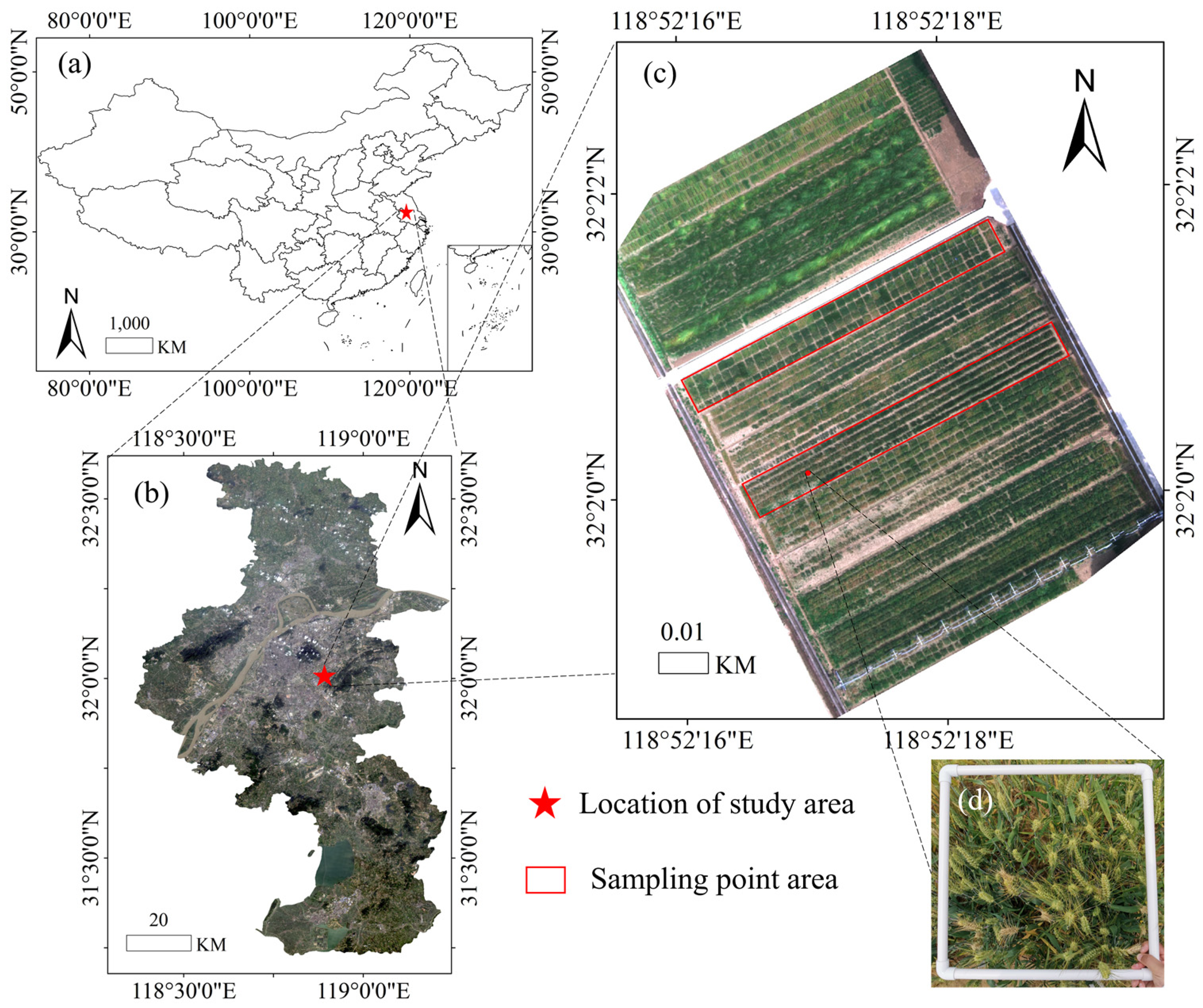

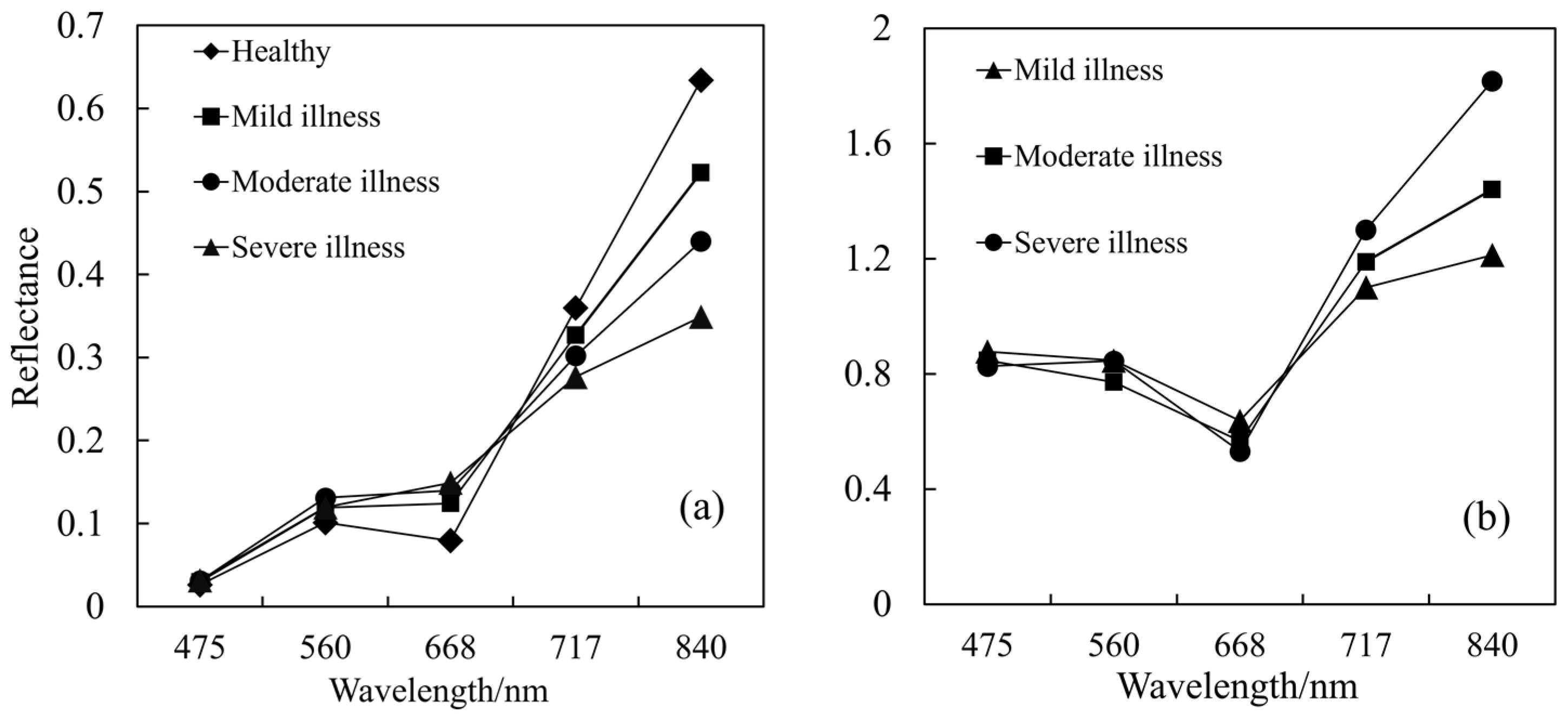

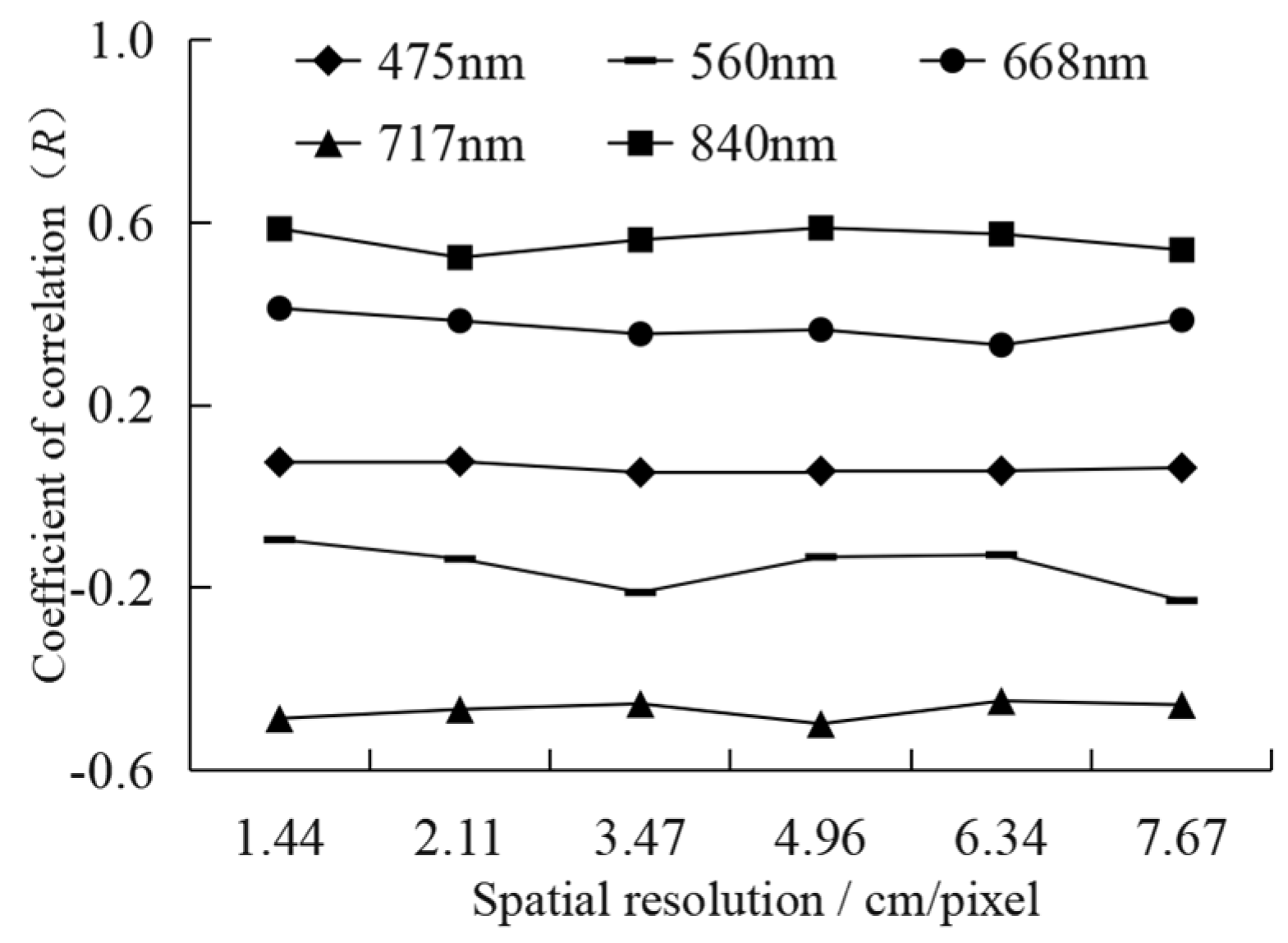
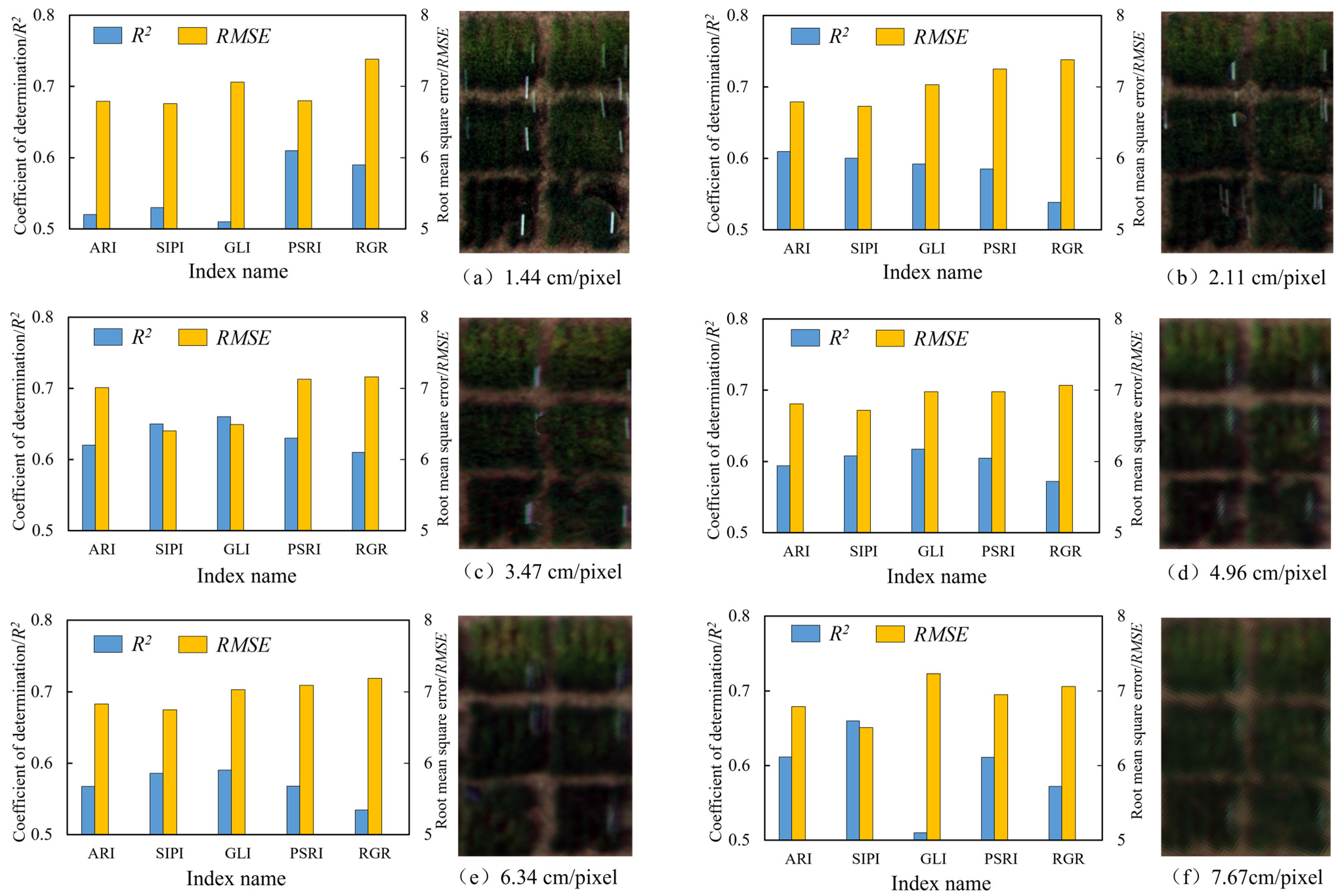

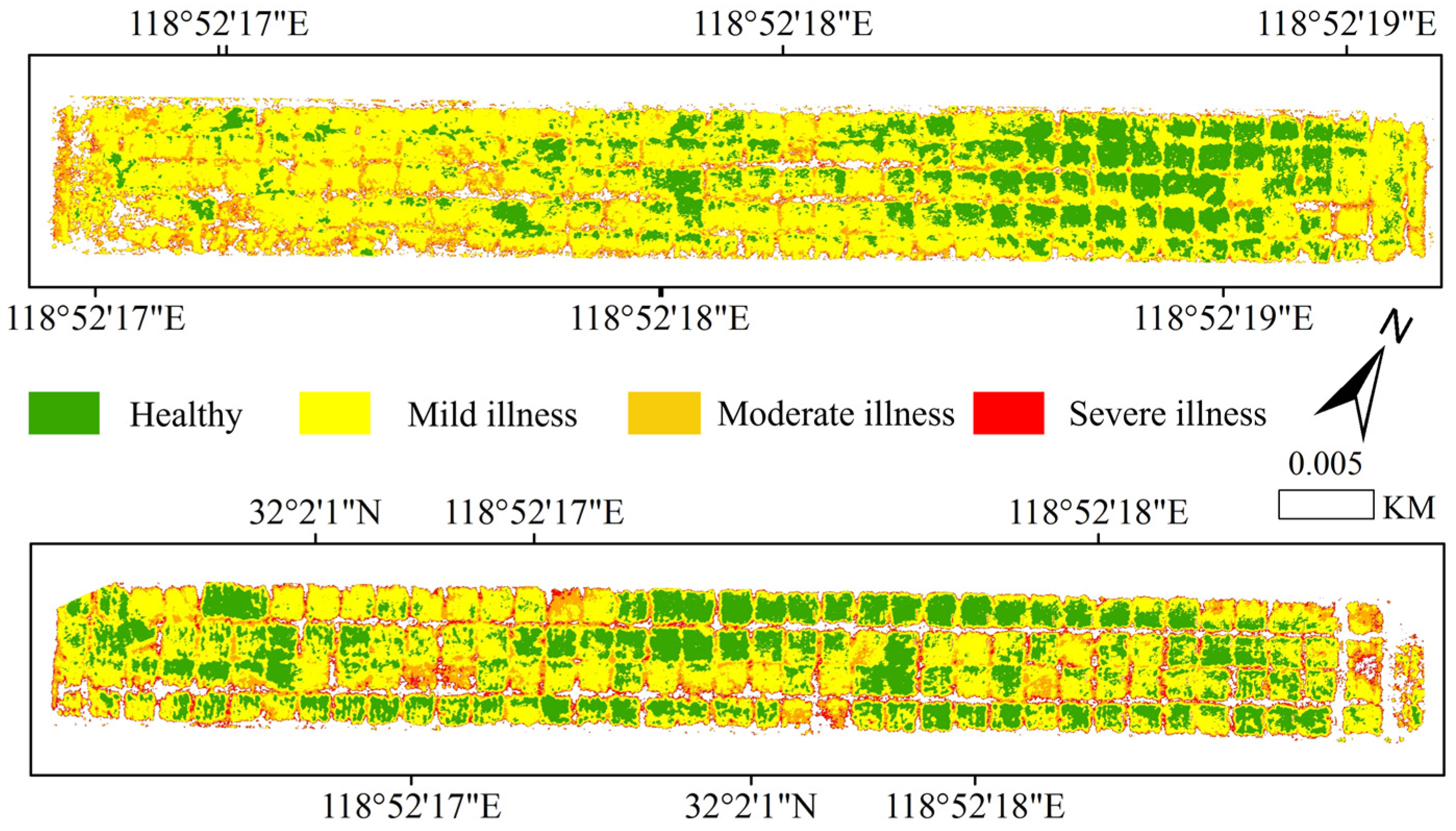
| Flight Altitude/m | Image Processing Time/min | Image Resolution/ (cm/Pixel) |
|---|---|---|
| 20 ± 0.1 | 32.33 | 1.44 |
| 30 ± 0.1 | 15.35 | 2.11 |
| 50 ± 0.2 | 7.87 | 3.47 |
| 70 ± 0.2 | 7.55 | 4.96 |
| 90 ± 0.2 | 5.58 | 6.34 |
| 110 ± 0.2 | 4.80 | 7.67 |
| Title | Definition | Description Formula | Reference |
|---|---|---|---|
| GLI | Green Leaf Index | (2g − r − b)/(2g + r + b) | [11] |
| OSAVI | Optimized Soil Adjusted Vegetation Index | (nir − r)/(nir + r + 0.16) | [13] |
| RDVI | Renormalized Difference Vegetation Index | [25] | |
| ARI | Anthocyanin Reflectance Index | 1/g − 1/r | [26] |
| CIrededge | Chlorophyll Index RedEdge | nir/re − 1 | [27] |
| SIPI | Structure Insensitive Pigment Index | (nir − b)/(nir − r) | [28] |
| GVI | Green Vegetation Index | (g − re)/(g + re) | [29] |
| Norm RRE | Normalized Red-RE | re/(nir + re + g) | [29] |
| NPCI | Normalized Pigment Chlorophyll Index | (re − b)/(re + b) | [29] |
| PSRI | Plant Senescence Reflectance Index | (r − b)/nir | [30] |
| MSR | Modified Simple Ratio | [31] | |
| NDVI | Normalized Difference Vegetation Index | (nir − r)/(nir + r) | [32] |
| NDVIrededge | Normalized Difference Vegetation Index RedEdge | (re − r)/(re + r) | [33] |
| GARI | Green Atmospherically Resistant Index | (nir − (g − (b − r)))/(nir + (g + (b − r))) | [34] |
| GDVI | Green Difference Vegetation Index | Nir − g | [34] |
| RGR | Red–Green Ratio | r/g | [34] |
| CRI2 | Carotenoid Content Index 2 | 1/g − 1/nir | [35] |
| EVI | Enhanced Vegetation Index | 2.5 × (nir − r)/(nir + 6r − 7.5b + 1) | [36] |
| CIgreen | Chlorophyll Index green | nir/g − 1 | [37] |
| TVI | Triangular Vegetation Index | 60(nir − g) − 100(r − g) | [37] |
| Spectral Parameters | Coefficient of Correlation (R) | Spectral Parameters | Coefficient of Correlation (R) |
|---|---|---|---|
| R475 | 0.07 | CIgreen | −0.54 ** |
| R560 | −0.09 | CRI2 | −0.19 * |
| R668 | 0.42 ** | EVI | −0.67 ** |
| R717 | −0.50 ** | GARI | −0.65 ** |
| R840 | 0.59 ** | GDVI | −0.60 ** |
| ARI | 0.72 ** | GLI | −0.71 ** |
| OSAVI | −0.69 ** | GVI | 0.58 ** |
| CIrededge | −0.54 ** | PSRI | 0.77 ** |
| SIPI | 0.73 ** | Norm RRE | 0.47 ** |
| MSR | 0.56 ** | NPCI | −0.39 ** |
| NDVI | −0.69 ** | RGR | 0.76 ** |
| NDVIrededge | −0.70 ** | TVI | 0.68 ** |
| Independent Variable Type | Number of Variables | Model Algorithm | Training Set | Validation Set | ||||
|---|---|---|---|---|---|---|---|---|
| R2 | RMSE | RPD | R2 | RMSE | RPD | |||
| VIs | 5 | PLSR | 0.73 | 5.14 | 1.56 | 0.72 | 4.32 | 1.61 |
| SVR | 0.79 | 4.83 | 1.88 | 0.77 | 4.79 | 2.30 | ||
| BPNN | 0.75 | 5.04 | 1.75 | 0.79 | 5.33 | 1.77 | ||
| TFs | 9 | PLSR | 0.64 | 7.56 | 1.37 | 0.59 | 6.32 | 1.26 |
| SVR | 0.69 | 6.17 | 1.51 | 0.63 | 6.63 | 1.45 | ||
| BPNN | 0.69 | 7.31 | 1.43 | 0.65 | 5.98 | 1.50 | ||
| VIs and TFs | 14 | PLSR | 0.76 | 5.23 | 1.64 | 0.76 | 4.21 | 1.67 |
| SVR | 0.81 | 4.27 | 1.88 | 0.83 | 3.35 | 2.72 | ||
| BPNN | 0.79 | 4.39 | 1.84 | 0.83 | 3.53 | 2.08 | ||
Publisher’s Note: MDPI stays neutral with regard to jurisdictional claims in published maps and institutional affiliations. |
© 2022 by the authors. Licensee MDPI, Basel, Switzerland. This article is an open access article distributed under the terms and conditions of the Creative Commons Attribution (CC BY) license (https://creativecommons.org/licenses/by/4.0/).
Share and Cite
Zhu, W.; Feng, Z.; Dai, S.; Zhang, P.; Wei, X. Using UAV Multispectral Remote Sensing with Appropriate Spatial Resolution and Machine Learning to Monitor Wheat Scab. Agriculture 2022, 12, 1785. https://doi.org/10.3390/agriculture12111785
Zhu W, Feng Z, Dai S, Zhang P, Wei X. Using UAV Multispectral Remote Sensing with Appropriate Spatial Resolution and Machine Learning to Monitor Wheat Scab. Agriculture. 2022; 12(11):1785. https://doi.org/10.3390/agriculture12111785
Chicago/Turabian StyleZhu, Wenjing, Zhankang Feng, Shiyuan Dai, Pingping Zhang, and Xinhua Wei. 2022. "Using UAV Multispectral Remote Sensing with Appropriate Spatial Resolution and Machine Learning to Monitor Wheat Scab" Agriculture 12, no. 11: 1785. https://doi.org/10.3390/agriculture12111785




